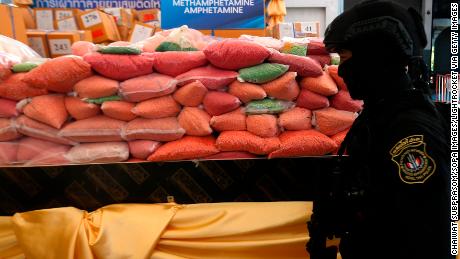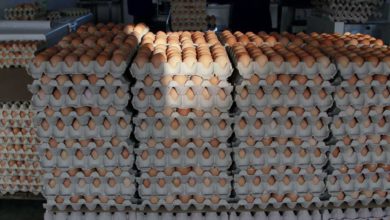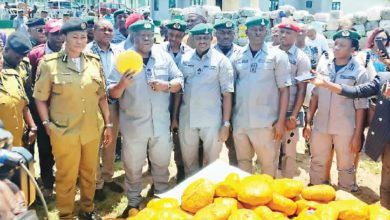
- A unit of armed border officers were on duty in Thailand's northern Chiang Mai province late last month when they stumbled on a cave stuffed with drugs.
Deep in the jungle in Thailand’s northern Chiang Mai province, a unit of armed border officers were on duty late last month when they stumbled on a cave stuffed with drugs.
The stash was huge. Inside were more than 5 million methamphetamine pills — known locally as yaba or “madness drug” — and 145 kilograms (about 320 pounds) of crystal methamphetamine wrapped in large plastic bags.
Even by conservative estimates, the haul was worth tens of millions of dollars, according to the United Nations Office of Drugs and Crime (UNODC). It was the biggest stash Police Lt. Col. Dilok Arinpeng, who commands the unit, said he had ever seen — and, incredibly, he found it unguarded.
A UNODC report published Thursday found the methamphetamine trade is now worth between $30 billion and $61 billion per year in East and Southeast Asia, Australia, New Zealand and Bangladesh.
Meth is being sold at rock-bottom prices, seizures appear to be doing little to dent the operations of drug traffickers, and crystal meth from the region is feeding demand as far away as New Zealand.
Jeremy Douglas, the regional representative for the UNODC’s Southeast Asia and Pacific operations, called on governments globally to “get their heads around the scale and significance” of the problem.
If they don’t, he warned, the situation will only worsen.
“The region is being used and abused by organized crime to do business,” Douglas said. “It is no stretch to say parts of it have become their playground.”
Armed Thai navy personnel in a boat during a patrol along the Mekong river bordering Thailand and Laos on May 23.
Lax regulation in Shan State, coupled with its porous borders, have enabled meth makers to easily import the required chemicals to make meth. Poorly enforced money laundering controls allow kingpins to easily clean their millions.
In recent years, another factor has driven business.
Significant investment has been made in new highways and bridges in southeast Asia, built to move products like food and clothing. But these new roads are also being used by smugglers to import chemicals and export their finished products, said John Coyne, a former head of strategic intelligence with the Australian Federal Police.
All of that combined is creating what the UNODC calls “the world’s largest and most dynamic” methamphetamine market, which has led to drug seizures reaching levels “unimaginable a decade ago.”
In 2018, authorities seized a record-breaking 120 tons of crystal and pill methamphetamine in the Asia-Pacific region. More than half of those busts took place in Thailand, where authorities confiscated more than 515 million meth pills, according to UNODC.
But the problem isn’t limited to Thailand.
The UNODC report found that organized crime groups are not only moving “staggering” amounts of meth to meet demand — they are also trying to increase demand, by flooding the region with incredibly cheap product.
That’s led synthetic drug prices, especially yaba, to hit historic lows in Southeast Asia, according to the UNODC.
Clearly, the record-breaking seizures haven’t put a dent in prices.
“Price is a good indicator of supply and that just indicates that the supply is extremely high,” Douglas said. “The surge of meth production is continuing and the factories running out of Myanmar are operating at full tilt.”
On June 5, Thai drug authorities held a press conference to announce their seizure of 1.5 tonnes of crystal meth.
Cheap pills are generally trafficked into Thailand, Laos, China and Myanmar. But organized crime groups have another, more lucrative revenue stream.
The higher purity crystal meth is taken to ports and shipped to richer markets such as Australia, Japan, New Zealand and South Korea.
While those four countries have modest populations, they account for about one-third of the estimated $61 billion methamphetamine market, because consumers there pay far more for the drug, according to the UNODC.
While the Philippines, Sri Lanka and Bangladesh have waged bloody drug wars in a bid to crackdown on this problem, other countries are focusing on borders and customs enforcement.
But Thailand has emerged as the real front line in this fight against the meth trade.
That’s due to both the country’s proximity to the Myanmar production hubs and a renewed focus by the authorities to combat the trade.
At the beginning of 2019, the Thai authorities began an “intensification campaign” along the country’s northern border with Myanmar, according to the UNODC’s Douglas. That’s where the main route used to transport meth through Thailand starts.
But that effort has just sent enterprising traffickers out in search of new routes. Thai police say some operations now send their meth east, using the 800 kilometer portion of the Mekong River that separates Thailand from Laos. Three days after the cave discovery in northern Thailand, police seized 100,000 pills at a checkpoint in the province of Kanchanaburi western Thailand, which borders southern Myanmar.
“Those routes are much more prominent this year than ever before. In fact, the Kanchanaburi route has in the past been used very little. That’s quite prominent this year, which has surprised everybody,” said Douglas of the UNODC.
The UNODC report noted that it has found “large quantities” of meth are also being trafficked through Laos — which also borders Myanmar — to Vietnam, which has ample coastline for shipping to nearby markets such as Malaysia and the Philippines, but also to Australia and New Zealand.
Coyne, the former Australian Federal Police official, said drug gangs have upended the traditional “narco-economics perspective” by creating “a new world of oversupply.”
The capacity to simply ramp up production has allowed meth producers “to write off large seizures as a cost of doing business,” said Coyne.
“We’re seeing here is very clear evidence that the current law enforcement strategies are not impacting supply or organized crime regionally,” he said.
“There needs to be a distinct rethink on what we do.”



